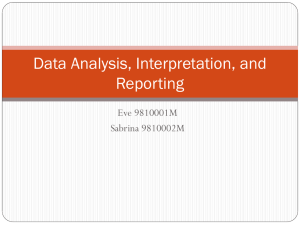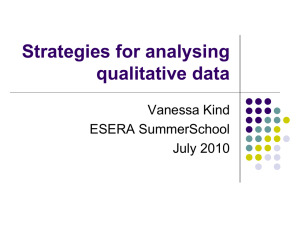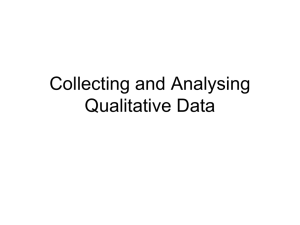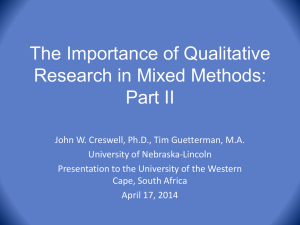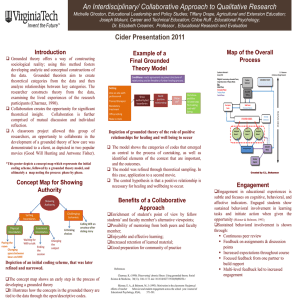an overview of possible qualitative analytical approaches
advertisement
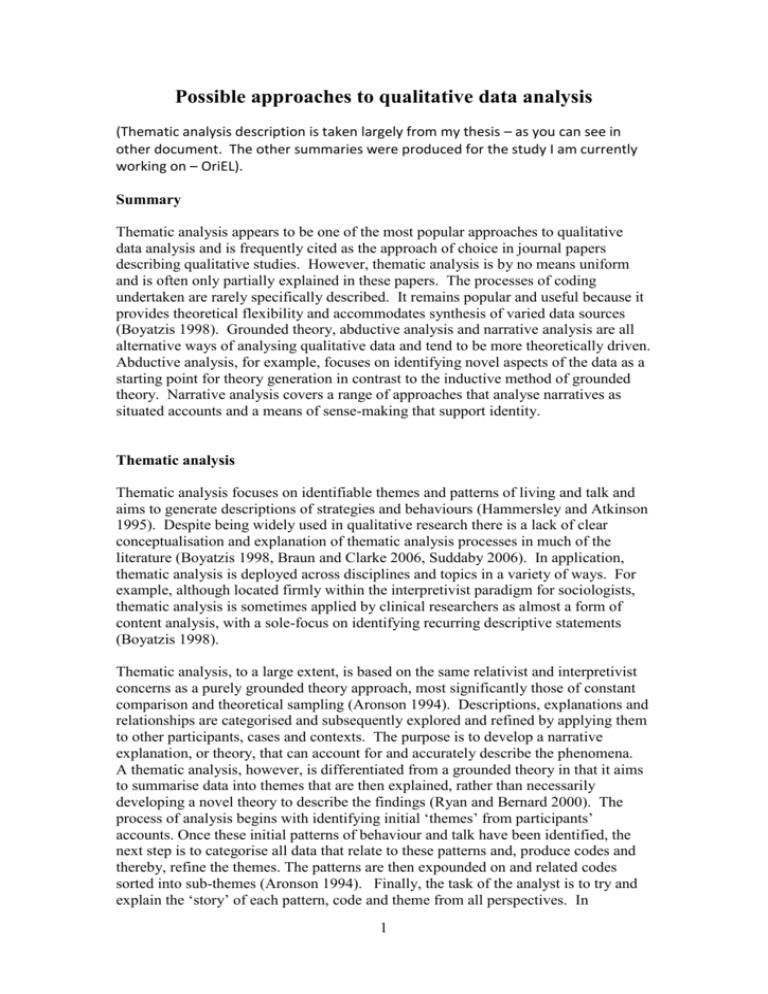
Possible approaches to qualitative data analysis (Thematic analysis description is taken largely from my thesis – as you can see in other document. The other summaries were produced for the study I am currently working on – OriEL). Summary Thematic analysis appears to be one of the most popular approaches to qualitative data analysis and is frequently cited as the approach of choice in journal papers describing qualitative studies. However, thematic analysis is by no means uniform and is often only partially explained in these papers. The processes of coding undertaken are rarely specifically described. It remains popular and useful because it provides theoretical flexibility and accommodates synthesis of varied data sources (Boyatzis 1998). Grounded theory, abductive analysis and narrative analysis are all alternative ways of analysing qualitative data and tend to be more theoretically driven. Abductive analysis, for example, focuses on identifying novel aspects of the data as a starting point for theory generation in contrast to the inductive method of grounded theory. Narrative analysis covers a range of approaches that analyse narratives as situated accounts and a means of sense-making that support identity. Thematic analysis Thematic analysis focuses on identifiable themes and patterns of living and talk and aims to generate descriptions of strategies and behaviours (Hammersley and Atkinson 1995). Despite being widely used in qualitative research there is a lack of clear conceptualisation and explanation of thematic analysis processes in much of the literature (Boyatzis 1998, Braun and Clarke 2006, Suddaby 2006). In application, thematic analysis is deployed across disciplines and topics in a variety of ways. For example, although located firmly within the interpretivist paradigm for sociologists, thematic analysis is sometimes applied by clinical researchers as almost a form of content analysis, with a sole-focus on identifying recurring descriptive statements (Boyatzis 1998). Thematic analysis, to a large extent, is based on the same relativist and interpretivist concerns as a purely grounded theory approach, most significantly those of constant comparison and theoretical sampling (Aronson 1994). Descriptions, explanations and relationships are categorised and subsequently explored and refined by applying them to other participants, cases and contexts. The purpose is to develop a narrative explanation, or theory, that can account for and accurately describe the phenomena. A thematic analysis, however, is differentiated from a grounded theory in that it aims to summarise data into themes that are then explained, rather than necessarily developing a novel theory to describe the findings (Ryan and Bernard 2000). The process of analysis begins with identifying initial ‘themes’ from participants’ accounts. Once these initial patterns of behaviour and talk have been identified, the next step is to categorise all data that relate to these patterns and, produce codes and thereby, refine the themes. The patterns are then expounded on and related codes sorted into sub-themes (Aronson 1994). Finally, the task of the analyst is to try and explain the ‘story’ of each pattern, code and theme from all perspectives. In 1 summary, a thematic analysis is a search for themes that emerge as being important to the description of the phenomenon. These emerging themes then become categories for analysis (Fereday and Muir-Cochrane 2006). One of the advantages of this approach is that it enables researchers to use a wide variety of types of information in a systematic manner, due to the theoretical flexibility it entails, and is therefore very useful in synthesising data from different sources (Boyatzis 1998). Braun and Clarke (2006) explain that, unlike grounded theory or conversation analysis (CA), a thematic analysis is not tied to a particular theoretical or epistemological position. As a method of analysis it is essentially independent of theory and can, therefore, be applied across a range of theoretical and epistemological approaches. Thematic analysis is a process for encoding qualitative information, rather than a theoretically informed model for research and analysis (Boyatzis 1998). Grounded Theory Grounded theory consists of gathering qualitative data and, at the same time working out theories and hypotheses and concepts in relation to the data being collected. In analysis concepts emerge from the data and are taken back to see if they are adequately representative (Eyles and Smith 1988). Categories can be continually modified to include new information. Description, classification and connection are conducted in an iterative, rather than linear, process (Kitchin and Tate 2000). Grounded theory analysis has three stages: open coding, axial coding and selective coding. Open coding involves describing and naming initial features of the data and phenomena being studies. Axial coding involves trying to ‘fit’ the data together and identify causal relationships. Selective coding is the selection of the core category and systematically relating them to other categories (Kitchin and Tate 2000). The core category is the central phenomenon. The theories and categories generated are verified through theoretical saturation. Eventually, new data ceases to add to existing knowledge about a category, at which point coding and analysis of that category have reached saturation. This method can be approached in a variety of ways and there is some disagreement over its exact processes and scope (Charmaz 2006). There have been a number of methodological critiques and commentaries arguing that qualitative researchers are increasingly describing their analytical approach as a grounded theory, yet what they are actually deploying is a general method of comparative analysis that could just as easily be described as a thematic analysis (Thorne 2000, Suddaby 2006). These analyses are situated in, and in dialogue with, wider bodies of literature and research. A purely grounded theory approach, by contrast, recommends that: "An effective strategy is, at first, literally to ignore the literature of theory and fact on the area under study, in order to assure that the emergence of categories will not be contaminated by concepts more suited to different areas" (p. 37) (Glaser and Strauss 1967) 2 More ‘purist’ interpretations of grounded theory, such as the one quoted above, have come to be replaced by constructivist approaches that aim for plausibility rather than irrefutability, and an acceptance that existing research and literature on a topic should not be dismissed, even at the outset (Charmaz 2003). Grounded theory remains a widely used, discussed and contested approach. For example, Gray and Smith (2000) deployed a grounded theory analysis in their 4year qualitative longitudinal study of mentoring student nurses. Eight participants were interviewed about their experiences and the authors describe their application of grounded theory as ‘a general methodology for developing theory that is grounded in data which are gathered and analysed using the constant comparative process.’ (Gray and Smith 2000) (p.1544). In total, 28 categories emerged from the analysis and were then collapsed into five major categories. The core category of “the professional socialisation of HE Diploma in Nursing students” was arrived at through ‘a critical process in which relevant literature was also reviewed’ (Gray and Smith 2000) (p.1545). This represents a more constructivist, rather than ‘purist,’ grounded theory approach as existing theories and research were factored into the analysis. Abductive Analysis An abductive approach to analysis builds upon Charmaz’s constructivist interpretation of grounded theory (Ong 2012). In essence, it is a development from the inductive stance of grounded theory (i.e. theory development driven exclusively by the data) to an abductive analysis which consists of looking at the data and identifying aspects that contradict or do not fit with existing theory. These novel or surprising points should then be the starting point for generating theory. Timmermans and Tavory (2012) explain that abduction is a creative inferential process aimed at producing new hypotheses and theories based on surprising research interviews. The authors accept that the approach does require familiarity with a wide range of theories and the ability to be both critical and unbiased in comparing findings to existing research and theories. There are three distinct stages of data analysis: revisiting; defamiliarisation; and alternative casing. The analyst must first revisit and re-interpret the data to position the experience, to allow relevance and focus to develop until it becomes ‘theoretically salient’. The analyst must then defamiliarise themselves from the data through inscription, through interrupting, restarting and re ordering the data. This should provide opportunities and modes of thought that are often glossed over in the first instance and challenge the taken-for-granted. Lastly, the researcher must think through different conceptual and theoretical frameworks. In practice, this would mean taking a relatively small data excerpt and working through it in detail trying to find as many possible ways to understand the data as can be found (Timmermans and Tavory 2012). Narrative Analysis 3 As with the approaches described above, there are a variety of ways in which narrative analysis can be theorised and applied. Greenhalgh and colleagues (2005) comment that a narrative analysis of personal stories take the story as a whole, rather than trying to segment it into themes. They reference Muller’s1 five overlapping stages of narrative analysis: entering the text (preliminary coding); interpreting; verifying (seeking alternative explanations); representing (writing an account); and illustrating (finding representative quotes). The structure of the story as a whole and the context in which it is told must remain in focus (Greenhalgh, Russell et al. 2005). The authors also highlight an alternative conception of narrative research as developing shared meanings rather than writing stories. Narratives can be used in collective sense-making, as a way of understanding change and incorporating it into an individual’s cognitive schema (Greenhalgh, Russell et al. 2005). Thomson and Holland (2003), in a similar vein, describe narratives as community resources on which individuals can draw. They undertook qualitative longitudinal data analysis for a UK based study following 100 young people over a 9-year period. Their approach aimed to capture the narrative character of individual accounts, track changes to them over time, and identify processual features such as narrative style, pacing and structure. Additionally, they also analysed the substantive content of personal narratives such as conceptual categories, like linked lives, agency, time and place. In practice this meant that individual narrative analyses were undertaken after each interview and a ‘summary narrative analysis’ was written for each location which identified local themes. Also, the researchers recorded their own personal reflections on the interviews and their predictions at the end of each round of data collection. These varied analyses were then drawn together to form a ‘case profile’ tracing changes and continuities in narratives over time (Thomson and Holland 2003). Alternatively, a discursive analysis of personal narratives emphasises the significance that individuals place on issues of stake and interest, and how attitudes, habits and social practices are interwoven with notions of contextual identity (Potter 1997). Self-narratives and personal stories serve as forms of social accounting and public discourse, open to continuous alteration (Gergen 2001). There is a substantial body of literature on health and illness narratives in medical sociology (Horton-Salway 2001). A discursive narrative analysis begins at transcription. The researcher listens to the conversation over and over to produce a more detailed rendering of the key moments and to identify where temporal or topical narratives begin, end and are interrupted. Interpretative categories, ambiguities in language, contradictions and dilemmas can then be identified as the narrative segments of the transcription are categorised (Kohler Riessman 1993). References Aronson, J. (1994) A pragmatic view of thematic analysis. The Qualitative Report 2, Boyatzis, R. (1998). Transforming qualitative information: thematic analysis and code development. London, Sage. 1 Muller, J. (1999) Narrative approaches to qualitative research in primary care. In: Crabtree BF, Miller WL, eds. Doing qualitative research. 2nd edition. London: Sage,221-38. 4 Braun, V. and V. Clarke (2006). "Using thematic analysis in psychology." Qualitative Research in Psychology 3(2): 77-101. Charmaz, K. (2003). Grounded theory: Objectivist and Constructivist Methods. Strategies of Qualitative Enquiry. N. K. Denzin and Y. S. Lincoln. London, Sage. Charmaz, K. (2006). Constructing Grounded Theory: a practical guide through qualitative analysis. London, Sage. Eyles, J. and D. M. Smith (1988). Interpreting the geographical world : qualitative approaches in geographical research. Cambridge, Polity. Fereday, J. and E. Muir-Cochrane (2006). "Demonstrating Rigor Using Thematic Analysis: A Hybrid Approach of Inductive and Deductive Coding and Theme Development." International Journal of Qualitative Methods 5(1): 80-92. Gergen, K. (2001). Self-Narration in Social Life. Discourse Theory and Practice: a reader. M. Wetherell, S. Taylor and S. Yates. London, Sage. Glaser, B. G. and A. L. Strauss (1967). The Discovery of Grounded Theory: strategies for qualitative research. Chicago, Aldine. Gray, M. A. and L. N. Smith (2000). "The qualities of an effective mentor from the student nurse's perspective: findings from a longitudinal qualitative study." Journal of Advanced Nursing 32(6): 1542-1549. Greenhalgh, T., et al. (2005). "Narrative methods in quality improvement research." Quality and Safety in Health Care 14(6): 443-449. Hammersley, M. and P. Atkinson (1995). Ethnography. London, Routledge. Horton-Salway, M. (2001). The construction of M.E.: The Discursive Action Model. Discourse as Data: a guide for analysis. M. Wetherell, S. Taylor and S. Yates. London, Sage Kitchin, R. and N. J. Tate (2000). Conducting research into Human Geography: theory, methodology and practice. Harlow, Prentice Hall. Kohler Riessman, C. (1993). Narrative Analysis. London, Sage. Ong, B. K. (2012). "Grounded Theory Method (GTM) and the Abductive Research Strategy (ARS): a critical analysis of their differences." International Journal of Social Research Methodology 15(5): 417-432. Potter, J. (1997). Discourse analysis as a way of analysing naturally occuring talk. Qualitative Research. D. Silverman. London, Sage. 5 Ryan, G. W. and H. R. Bernard (2000). Data management and analysis methods. Handbook of qualitative research. N. Denzin and Y. Lincoln. California, Sage: 769802. Suddaby, R. (2006). "From the editors: what grounded theory is not." Academy of Management Journal 49(4): 633-642. Thomson, R. and J. Holland (2003). "Hindsight, foresight and insight: the challenges of longitudinal qualitative research." Social Research Methodology 6(3): 233-244. Thorne, S. (2000). "Data analysis in qualitative research." Evidence Based Nursing 3: 68-70. Timmermans, S. and I. Tavory (2012). "Theory Construction in Qualitative Research: From Grounded Theory to Abductive Analysis." Sociological Theory 30(3): 167-186. 6

